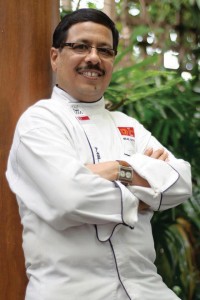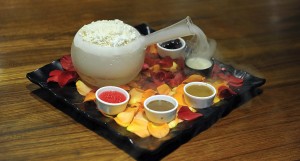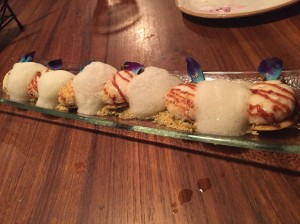Heer Paresh Kothari explores a whole new facet of cooking, the art called molecular gastronomy
After a gruelling week, and a literal jungle book stirring in your stomach it’s time you gave yourself a lip-smacking, mouth-watering treat this weekend. Can you think of normal foods, assuming an unconceivable and unique form, which when popped into your mouth exuberate this distinct burst of flavours that tickle your palette? Foods that look so different and still seem familiar? The food that’s fit for the Gods! Well the cuisine maybe the same or perhaps an interesting blend of two cookeries, forming a fascinating form of food famously called molecular gastronomy.
Defining it
Well, what is Molecular gastronomy and is it any different from fusion food? Both food forms are very unusual. They also require specific apparatus and cooking time depending on the dish that’s to be prepared. According to Chef Harsh Shodhan, of the Gourmet Kitchen & Studio (Mumbai), “Fusion food is the collaboration of two different cuisines, may it be in the form of taste, texture and presentation such that the final outcome gives you the experience of both cuisines. On the other hand, Molecular Gastronomy is the changing of the molecular structure of the ingredient or the dish without affecting the basic coherent taste of the ingredient or the dish.” Master Chef Milind Sovani insists, “Molecular gastronomy is more about the visual appeal and the novelty of textures and taste.” The term may sound like we have notched a new high in the food sciences; however, it is only the simple and successful Milind Sovani application of scientific principles and practices in the preparation of food. This form of cooking is almost a few decades old but seems to have rippled attention only in the recent years. Started by renowned chefs Ferran Adria and Heston Blumenthal, molecular gastronomy incorporates laboratory techniques that can be tastefully applied to any cuisine.
Simplifying it
Imagine nipping on an apple flambé (with your eyes shut) normally cooked using regular apparatus. One will only experience a mash of flavours, which even after trying hard will be difficult to distinguish. Don’t be surprised if you will label the flambé as a potato with a dash of sweetness. This is because whenever we heat an ingredient, it causes a chemical reaction, resulting in the loss of the original flavour.
Molecular gastronomy enables patrons to fully cherish flavours of every ingredient involved. Take the Dahi Wada at SpiceKlub in Mumbai for instance. The Wada Caviar is soaked in Dahi, enabling patrons to cherish a definite flavour of the curd and all the spices used. The menu also has the delicious Cheese Pav Bhaji that has changed the physical form to the consistency of the fondue.
Myths galore
Molecular cooking involves the use of controlled temperatures, food grade chemicals and specific apparatus. There is a common myth associated with molecular gastronomy that the food heavily relies on the use of chemicals. This is absolutely incorrect. According to Chef Sovani, all the ingredients are sourced from natural produce. Chef Shodhan states, “It is a complicated form of cookery. Not only is it difficult to make, but it is also considered very expensive,” Aditya Gupta, owner of SpiceKlub states that many people are oblivious to this form of cooking, and think it is strange! It is only when they come in to his restaurant and savour the delights; do they understand what they’re consuming.
The Technique
Molecular gastronomy involves a lot of research, food grade chemicals for ingredients and the appropriate apparatus (which can also be shipped) to craft the perfectly flavoured dish. Women can try this at home too! “Don’t be disheartened if you are unable to get the dish right in the first try. The preparations indeed require a lot of patience,” adds Chef Sodhan. Techniques like Sous-vide, are commonly used in this form of food science. This involves, cooking in vacuum packs, using water baths that are controlled at 62.8 degrees, in order to retain its natural colour, juices, and tenderness. Pav Bhaji Fondue, SpiceKlub Mumbai Bubbling Kulfi, SpiceKlub Mumbai Test Tube Pani Puri, SpiceKlub Mumbai Traditionally devised for medicinal purposes, spherification, jellification, Faux Caviar, is now routinely included in the preparation of some lip-smacking dishes and cocktails. Jellification is just another technique that is frequently used in this form of cooking. Liquids are converted into gelatinous substances using gelling agents like agar-agar, gelatin, carageenan, gellan gum, pectin and methylcellulose. These jellying agents are solid in nature, but assume the appropriate form on hydration. Some of the best cocktails can be prepared using this technique. One can relish these yummy coolers at the J.W. Marriot, Courtyard, ARK. Chef Suresh Thampy, Executive Chef, at the ARK Courtyard Marriot adds, “We, at JW Marriott Mumbai are excited to include molecular gastronomy in our cocktails which lends a unique taste and flavour to the drink. This drink is elegant, crisp and rich in taste which sets it apart from the others.”
Flash Freeze is another technique used in molecular gastronomy comprising of the immediate freezing of foods, with the use of liquid nitrogen. Transparent sheets for Raviolis are created using soybean and potato starch. Prints can be applied onto the edible transparent sheets using fruit flavours for ink followed by the laser-printing technique. The transparent edible sheets are neutral in flavour and can be used in the main course as well as in desserts. Maltdextrin is famously used to convert high-fat liquids like oil or clarified butter to powder. And food stabilisers are also used to convert fruits and vegetables into edible foam.
The Effect
Molecular gastronomy has quite a magical effect on food lovers. It spells good news for those on a diet. The calorie measures are lesser than when one consumes normal food. The secret lies in keeping it simple. That is an assured way of inducing the ‘wow factor’ among food lovers. According to Chef Suresh Thampy, “Numerous studies are being done to see if dieters looking for a bit of help to lose weight could benefit from the science of molecular gastronomy. Some research suggests that people looking to shed a few pounds could be given an edible gel that swells in the stomach to make them feel fuller. Scientists and chefs are currently working on a way of combining two food ingredients that when they are exposed to stomach acid will expand to form a solid gel. As gel like protein is harder to digest and takes time to break down, it leaves the person feeling less hungry and therefore reduces their desire to overeat.”
For those who are keen on learning how to prepare dishes, Chef Sodhan invites learners to his studio. He adds, “Apart from my commercial catering business which we run out of The Gourmer Kitchen & Studio, we also conduct various culinary based hands-on classes, workshops, demonstrations and master-classes conducted by our in-house faculty and visiting chefs ad experts.” The studio is planned in a way, giving students an opportunity to independently cook and prepare dishes at their work stations in teams of two. He adds, “We would like our students to experience and feel what they are cooking and learning and would love them to get their hand dirty!” The Gourmet Studio and kitchen is equipped with the best and yet basic equipment. One can replicate the recipe back home. They also have a 10 seater dining table where students can eat and enjoy their preparations. The place can be converted to a private dining room for family gatherings and private parties. As we wind up, we notice that molecular gastronomy is seriously taking the country by storm. Many restaurants have begun luring patrons by crafting some delectable preparations using this unique technique. However, there are still many who are unaware of this food form. But, there are also many who watch and learn to cook using basic, uncomplicated apparatus. After molecular gastronomy, the next level involves going organic using this form of cooking.
Here are two delectable molecular gastronomy recipes by Chef Milind Sovani of April Rain Restaurants India and Hospitatility Innovations, Singapore that you can try at home, by yourself!
SPICED SPHERES OF YOGHURT & TAMARIND ON PAPDI (A CLASSICAL PAPDI CHAT SERVED IN A MODERN MOLECULAR STYLE)
INGREDIENTS
Thick spiced youghurt (used in chat) 250 gms
Tamarind chutney 250 gms
Papdis 8-10
Sev 1 table spoon
Algin 3 teaspoons
Chilled water 500 ml
METHOD
• Mix algin powder with chilled water and blend it in a blender and keep the mixture in the refrigerator overnight
• Take thick youghurt with the regular chat spices in it and drop a spoon full in the algin water, it will form white spheres.
• Now drop a spoon full of thick tamarind cutney into the algin water and it will form red spheres.
• Carefully remove these spheres and drop them in a clean drinking water bath.
• Set papdis on a platter and top the papdi with the white yoghurt sphere, place the red tamarind chutney sphere next to it.
• Lightly sprinkle with thin sev and serve.
• When you eat the papdi with the topping, you will get a burst of flavours in your mouth which is highly enjoyable
A YUMMY COCKTAIL YOU CAN TRY MAKING AT HOME
INGREDIENTS
Whisky 45ml
Fresh apple 5- 6 chunks
Lime juice 15ml
Cinnamon stick 2 -3 sticks
Sugar syrup 15ml
Cigar and apple wood chips
Special equipment used Smoke gun and the wood chips
RECIPE
• Prepare the smoke of cigar and apple wood in a decanter by burning wood chips
• Store the smoke in the decanter by covering it with a lid
• Now, prepare the drink by muddling the apple chunks with cinnamon stick
• Add scotch whisky into it and fill the shaker with ice
• Add lemon juice and sugar syrup
• Shake and pour the ingredients in the old fashioned glass filled with ice
• Then remove the lid of the decanter filled with the smoke and invert it over the glass filled with the cocktail
• Let the smoke travel through the decanter into the glass
• Remove it and serve along with the smoke coming out of glass with the garnish of cinnamon stick
Volume 4 Issue 7
































